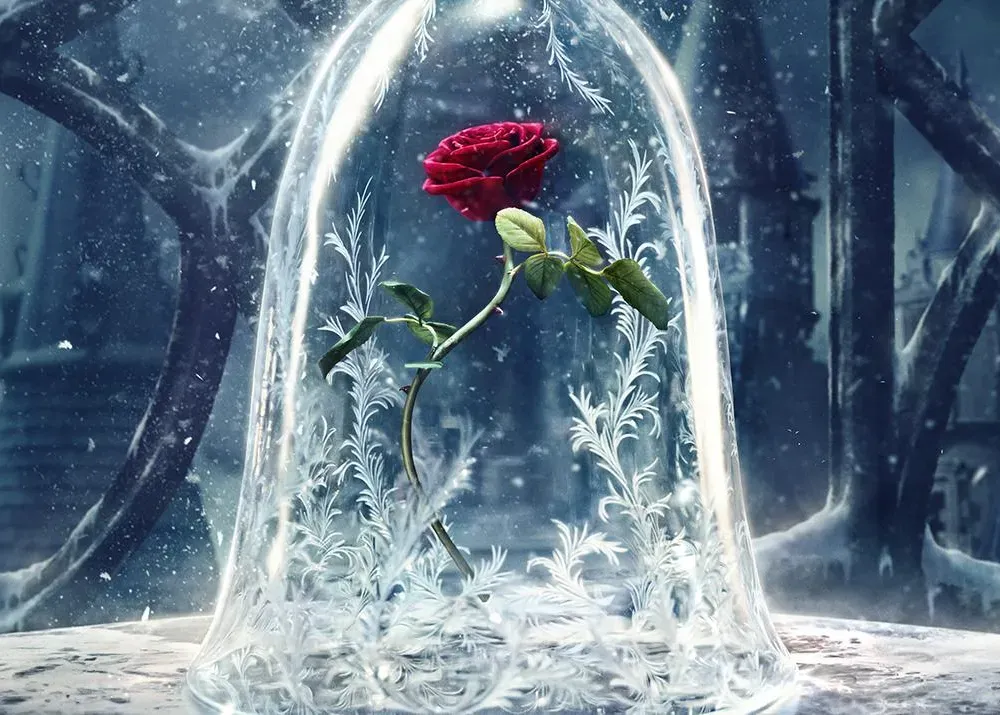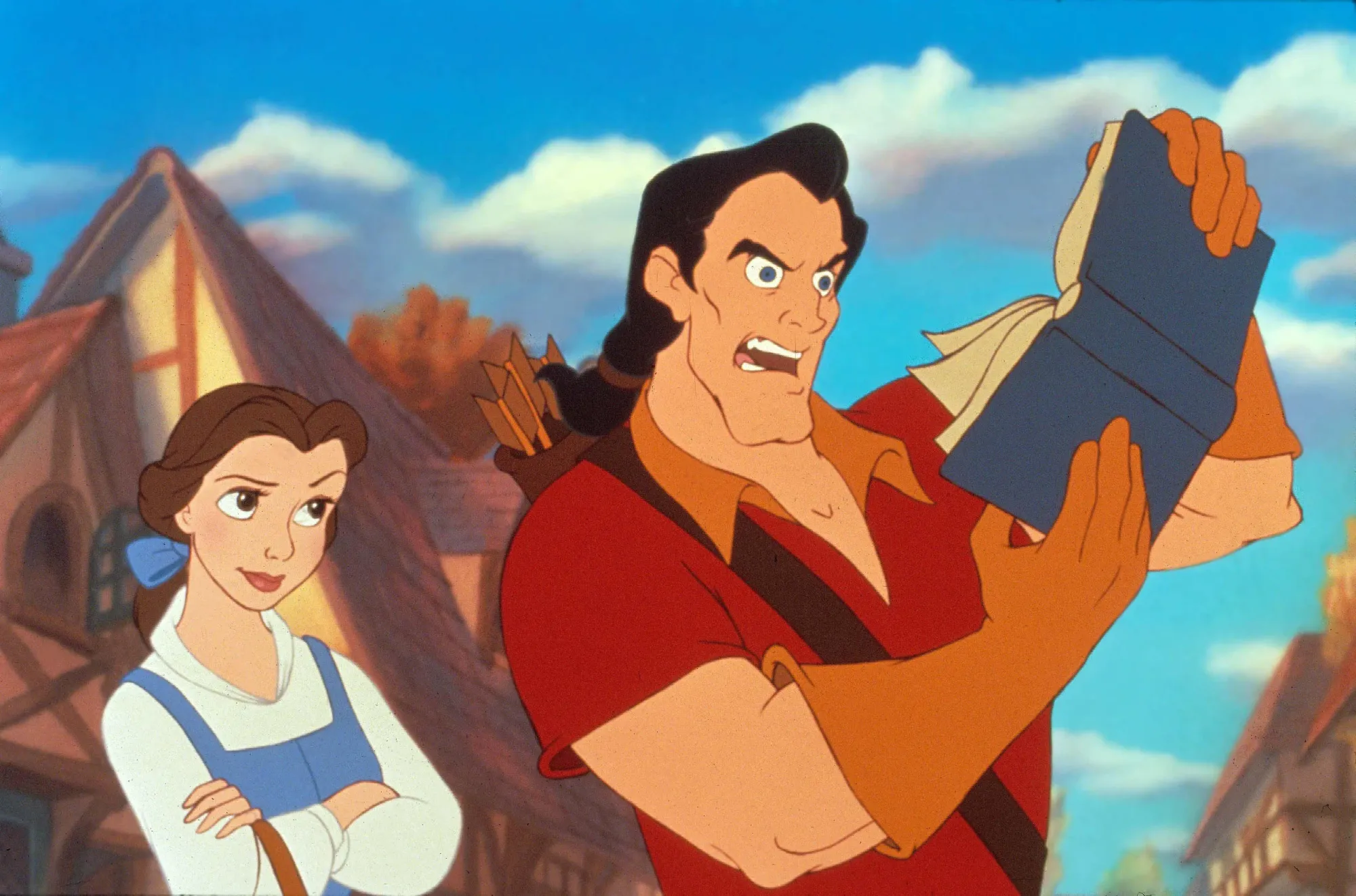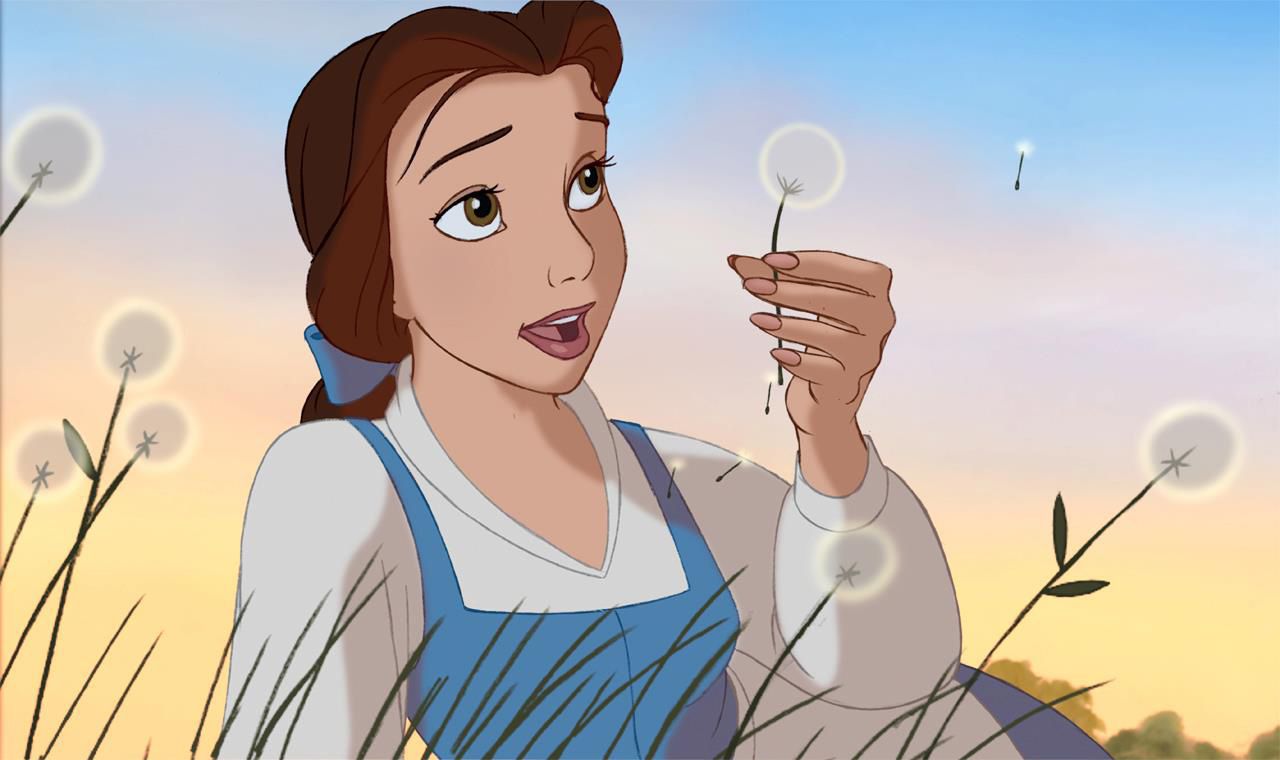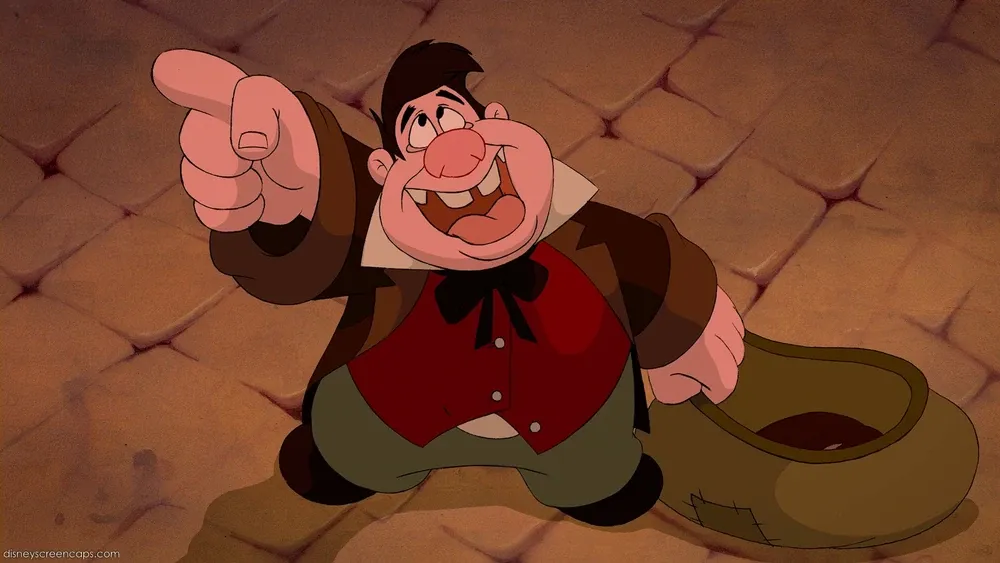Beauty & the Beast
AIDS Metaphors and Other Things

AIDS Metaphors and Other Things
Once upon a time, Walt Disney Studios released a daring animated film into our movie theaters that was, in fact, secretly about AIDS. That film, Beauty & the Beast, was a metaphor for the epidemic that appeared to be sweeping the land back in 1991, and it is a message that is still good today, as the scourge is still with us and others have joined it.

Some telltale signs are obvious: the film is dedicated to Howard Ashman, the song lyricist and creative genius behind it, who died of AIDS before the film was released. Then there was that song “Kill the Beast,” which seemed like an indictment of the vigilante mentality that had taken root in America in the early 90’s as parents lashed out at the AIDS-afflicted children in their neighborhood schools. And what was the Beast’s affliction exactly? He wasn’t a werewolf. And what about Gaston, that hyper-masculine figure who seemed to satirize the vain, gay bodybuilder and bathhouse culture of the 80’s? Finally, there was that evocative red rose, with its petals falling, that seemed like the life blood ebbing away in the lives of AIDS and HIV patients in our communities.
AIDS as a phenomenon and how society responded to it were very much on people’s minds back then, though only a few commentators made the connection with the movie and fewer still are aware of it now. Yet there we were, late in the 20th century, and the dark shadowy figure of the vampire was with us again in the fear of an epidemic, in the scapegoating of the gay community, the blood superstitions, the warnings about sex without love.
In those days of deadly diseases of the blood, you went out on a date and you wondered whether a blood test was required before progressing to the next stage, especially if you were gay or bisexual. Should it be over a glass of wine and the entrée or perhaps later over coffee, or could it wait for the bedroom? The danger has always been there really – for fear of the unknown has been part of the thrill of the chase. Schubert died of syphilis at the age of 31, the year after Beethoven, and they are buried next to each other in Vienna. Nietzsche went insane and it is generally attributed to the syphilis he contracted in his youth. The dilemma today is, if everyone else seems to be promiscuous, should you be too? Fear of the blood diseases appears not to have significantly diminished sexual activity but, along with the other sexually transmitted diseases, it has played its part in the mechanization and commercialization of sexuality today and the diminishing Western birthrate. Sex and death are linked once again and forever, giving new meaning to the line Till death do us part. Is there an unlikely upside to all this: can such fears about AIDS and STDs result in the rebirth of romance? After all, isn’t romance proportional to unfulfilled desire? Can romance make a comeback?
Gaston’s Story
Beauty & the Beast is a darkly cynical story that is designed to show that we live in an age without heroes. The real hero does not get the girl and dies instead of a broken heart. Gaston was that hero. He was a martyr, a sacrifice on the altar of political correctness by a rotten society that has elevated the beastly and the perverted and that does not respect family values anymore.

The villain, of course, was the Beast, for everyone was corrupted by his contagion. His disease, which was purely physical at first, soon spread to the mental plane, driving him nearly insane, and this only encouraged Belle’s natural maternal instincts in the wrong direction. Worse, she turned into a feminist. If Gaston had been allowed to sort things out, he could have had her locked up in the asylum with her father until she recognized her foolishness. Essentially the ending of the movie is all wrong because Gaston is killed off. One can only think of John Smith getting a bullet in the stomach at the end of Pocahontas to rival it for pusillanimity.
This film is about masculinity, or it ought to have been. It has an Oedipal story -- Mr. Bruno Bettelheim says so -- where Belle is supposed to transfer her love for her father onto Gaston as her future husband. That is why there is such a strong emphasis in the film on body-building, hunting, drinking, and joking around so she can transfer her affections from her wimpish egghead father Maurice to the more manly pursuits represented by Gaston. Indeed Gaston recommended that the story be updated and called “Gaston and Belle” but he was informed by the Studio that everybody knew the original title and they couldn’t change it for marketing reasons. Anyway Gaston buffed himself up for the role and he was very disappointed with Disney for how it turned out. They had promised him a role in a later picture about Tarzan but Eisner reneged on that deal too.
Gaston was sure it had something to do with the fact that his prior friendship with the Beast had somehow got out. He thought they had kept it a secret, so how did the Studio find out? Hollywood has codes for this sort of thing and secrets are not supposed to be revealed, yet somehow they knew and now they blamed him for it. Gaston did not consider himself responsible for the Beast’s affliction, but he knew the shadow would hang over him until he had rid himself of the stigma. It had been an indiscretion from an earlier time and he was ready to move on. He had thought about litigation but he had seen what they had done to the Winnie the Pooh people.
Gaston was surprised that no one had yet commented on how badly Disney had messed up the story. For years the feminists had hogged the debate, obsessed with finding negative “femininity” all over the place – the peelaway bathing suit worn by Ariel, the Pocahontas cleavage -- while conservatives howled about the phallic symbols on the Little Mermaid poster, the topless woman in The Rescuers and the word SEX in the sky of The Lion King. Even Gaston thought this absurd, but he saved his real venom for those who would argue that a white male dominated studio like Disney had let the white male imagination colonize women’s bodies all over the world. Imagine that! Gaston thought it had escaped most feminists that white men found women from other parts of the world more sexually exciting anyway. There were good reasons for this, not the least of which was that white women had become boring. Just look at Belle, for God’s sake. Western women were too critical, too predictable, too brittle and the only men they tolerated were feminized men like the Beast who sulked a lot and didn’t fight back. Gaston had the feeling he knew what most women were going to say before they said it. The fact that they wrote about femininity all the time only reflected their desperation. Feminist writing was self-therapy, reassurance, making the world right through writing. It was a total waste of time.
Another thing that riled Gaston was that Disney had been successful in persuading everyone that its version was the one and only, the authorized version. Just as all earlier storytellers were successful in pushing aside the previous ones, this too was Disney’s triumph, and it had been rewarded with an Academy Award nomination. Gaston wanted his revenge. He mused over the possibility that in the future there would be new video game technologies available to him that would lead to new narrative forms whereby he could completely transform Beauty & the Beast into “Gaston and the Beast” perhaps. Forget Belle. He would like the opportunity to design an ending more fitting to the story, where he would win the “girl,” whoever she was, and he would kill the Beast or ensure he stayed a Beast, or even turn him into a kept man again. Well, why not? There was nothing new under the sun, after all. Weren’t plagiarism and parody the sincerest forms of flattery? Now, if he could just figure out C++.
The Beast's Story
As Beauty & the Beast begins, the young prince is transformed into a Beast because of an act of arrogance and unkindness toward a woman old enough to be his grandmother. She turns out to be a beautiful young enchantress and she retaliates. The strange affliction she gives him transforms his shape, his being, his soul. The pustulence grows with his despair, like lava erupting across his skin, working itself through the seam lines and into the bloodstream. The ugliness prevents anyone from seeing any original beauty that may have remained. It becomes a mask, more animal, less human.

Metaphorically, one might say that the Beast is contaminated by the viruses of pride and vanity, of believing that since he is young he can live forever. One moment of bad luck; that was all it took to sweep it all away.
Beauty is a horrible concept anyway. It is a curse. From earliest times it was a gift from God, like wealth or a title. In the ancient epics and medieval fairy tales the heroines were beautiful, the heroes were handsome and noble in nature. The fairy wands in Sleeping Beauty, you will recall, bestowed the gift of beauty and the gift of song. Perfect beauty, however, was always stalked by the horror of disease. The fairies conveniently forgot, as they do every time, to add perfect health to their gifts, deliberately one suspects, in case they need to control us later. Malificent paralyses Aurora like a poisonous spider, the evil Queen poisons Snow White with the ripe red apple of sexual temptation. Circe’s magic wand strikes down Odysseus’ sailors… These stories are about the revenge of the fairy world upon humans, for humans, it turns out, can experience the sexual pleasure that the fairies are denied. They rage that human heroes and heroines have become the center of these stories, pushing the fairy world to the margins, to playing the villains. For the fairy world is all that survives of the great pagan universe of the gods and goddesses of the ancient world that were thrust aside by the successive invasions of Christianity, Islam and Disney animated movies. Humiliated and domesticated, all they have left is revenge.
The prince reflected on his snub of the enchantress. He felt it was more than simple spite. Had she perceived it as a rejection of her sexuality, her heterosexuality? Had she decided that his affliction, his Original Sin, was his essentially homosexual character? Was she some kind of anti-gay religious fanatic? Did the religious right have that kind of power? True, he could see that the metaphor worked to some extent. The deformity he now saw in the mirror and his isolation in this castle with the other disfigured furniture pieces resembled AIDS patients everywhere as they fled from human sight into hospices. His castle had become a private darkness that shut out the world but kept the soul somewhat intact, filled all the while with impotent rage and despair. Waiting, waiting, but for what? For Belle to arrive? To be his guest? What did that mean? He wished he knew.
Was perfection just a skin condition? It had always been so really. To be beautiful was to have escaped the smallpox scars and the rotting teeth of the commoners, but now humans had the opportunity to cheat fate through surgery. In the past humans always preferred that others did their suffering for them – they preferred to hear about it in stories. If once we were all aristocrats under the skin, nowadays we could all be aristocrats on the surface of the skin, no matter what was hidden beneath.
The prince knew that plastic surgery and liposuction wouldn’t affect his inner person. For the Beast was now at the other extreme where the ugly surfaces of his affliction reflected rather than masked the greater horror inside – the invisible virus. What was most frustrating about today’s culture was not that there was no physical cure. That could be taken care of by protease inhibitors and other chemical paraphernalia. What mattered was the implications of such a powerful link between sex and death. It disturbed him profoundly on a spiritual level. Why should the act that bestows life also be the act that bestows death? Was there some terrible cosmic irony to all this?

Let the doctors and researchers continue to find their miracle cures. What the prince felt was needed was a new aesthetic where, if AIDS was not exactly beautiful, then it could be ennobled, just as the suffering Madonna and the Magdalene became spiritual metaphors fashioned out of the pain and suffering of life in the Middle Ages. It was not just a miracle cure that was needed but a mythology that satisfied the imagination, that provided an explanation, no matter what Dr. Sontag from the asylum had to say about its inadequacies. It was not that we have difficulty accepting that the natural curve of our lives ends in death. What we seek is an explanation for all this suffering – an explanation that has nothing to do with Original Sin!
The prince knew that the hatred Gaston felt for him had little to do with his desire for Belle. Gaston wasn’t even interested in women. His decorating with antlers surely tipped you off? His ultra-masculinity produced a homophobic sexual energy that was also profoundly anti-feminine. When he sought to kill the Beast, he not only sought to kill the sexuality within himself, he was attempting to deny that he too had AIDS. Ever since he fell to his death from the castle walls, the media had written him off as a buffoon, but they never guessed the truth. The prince, for his part, assumed Gaston had committed suicide, the moment the HIV had progressed to full-blown AIDS. Of course he would be back; you couldn’t kill a cartoon character.
But the prince himself was still alive. With recent advances in medicine, he could not say if he would die soon after Gaston, but all those scenes of redemption at the end of the movie, while very charming, had been a polite lie for a mass audience. Gaston had been a handsome man but his had been the beauty and vanity of the male figure before the ravages of AIDS. For the Beast, what mattered was the discovery that we live with death circling around us and howling at the gate, asking, threatening to come in. Belle, he knew, believed in the power of romantic love and the moral and physical transformation that it brought, to keep death outside the walls. But the Beast could not bring himself to believe in this. He didn’t know any men who did. It was a sentimental cop-out. Did he plan to sleep with Belle? Condoms? No, the idea was too psychologically debilitating -- sperm as poison -- and anyway desire was stronger when it was unfulfilled. There was some spiritual comfort in that at least, in abstinence.
For the prince, as for all agnostics, for those without religious faith, one had to rely on the magic of the arts and sciences. Artists had the ability to capture memories of what has passed and what might have been and give them resonance. Scientists made them concrete. Along with regret and a sense of loss, there was also a sense that life is what it is and that there is romance in every moment of it if we only know how to enjoy it. We know as we get older that those moments are gone forever, except in memory, so why worry oneself about it? And there was always tomorrow.
Belle’s Story
Belle had begun teaching the village children at the local school after their former teacher was killed in the attack on the castle. She had been surprised to hear the teacher had helped lead the attack. If schoolteachers could so easily join in the hysteria, what hope was there for society? The children, curiously enough, wanted to hear more about the Beast and his story. Belle wondered whether she should address the subject of his disease directly. They did not understand TB, leprosy, cholera, let alone AIDS – these diseases that kill – but she thought perhaps they should understand them. The children did not even remember what it was like to have chicken pox or the measles. But they did understand when she told them that the Beast was sad and lonely because he felt ugly. They could even understand the fundamental unfairness and randomness of it. Not one child in the class condemned him for his homosexuality. Belle knew most of their parents felt otherwise.

The original writers of the story, Villeneuve and Beaumont, understood that the Beast suffered from much more than pride and vanity. They knew that physical ugliness also takes its toll, eating away at self-respect, destroying the spirit along with the tissue. This was why French filmmaker Jean Cocteau was drawn to the story: he made his La Belle et la bête in 1945, with a tormented tragic Beast. Homosexual, Cocteau felt an outcast many times in his life, but it was his disfiguring facial eczema that linked him so personally with this story. During filming he wore a black veil over his head with holes cut out for his eyes and his mouth. Truly a Beast mask, yet film historians rarely mention it. No doubt the same sentiment inspired Robert Louis Stevenson when he wrote The Strange Case of Dr. Jekyll and Mr. Hyde, for Stevenson was ravaged by tuberculosis, the poison inside transforming him into Mr. Hyde whenever he suffered a relapse, and he would be gone eight years later, in 1894. Did Milton feel the same way as he went blind; did Goya and Beethoven as they lost their hearing? Did Edgar Allan Poe as he watched Virginia Clemm fading away from tuberculosis? The same pessimism pervades Chekhov’s The Cherry Orchard and Kafka’s The Metamorphosis -- their authors deteriorated from the same disease. Dennis Potter’s The Singing Detective has psoriasis and the musician Seal, whose elegy “Kiss From a Rose” can be interpreted many ways, still bears the scars of lupus on this face.
Belle knew that these writers, like Howard Ashman, fought their killers heroically, transcending the pain and the despair through their art. The only other way, it seemed, was through religious faith. That was the path Belle had chosen, for she considered herself a teacher, not an artist. While she knew that the Beast despised religious solutions, she felt that women better understood religious faith than men. Religion was, after all, just a cluster of fairytales that expressed the ineffable. It had a certain wild magical power that defied the limits of reason. From the beginning of the l7th century, most women had not been allowed to study religion, philosophy and the law, and so they had developed an interest in fiction instead, especially fantastic and romantic writing. Ironically, that fiction upended the rules and laws dreamt up by the male authorities. When aristocratic and upper middle class girls were told the ancient folk tales by their nurses and maids, these tales were often violent and sexual, quite at odds with what the men would have had them learn. These tales were forerunners of what all women would encounter in their adult lives when they had to contend with forced marriages, unwanted pregnancies and disappointing husbands. The wild magic enabled women to look past the ugliness of men. Today, Belle wondered why so many women retained their interest in ultra-masculine heroes, the ones who longed for unattainable feminine heroines. Belle hoped that women would avoid the vain and spiteful Gastons and even the self-pitying and abusive Beasts of this world. Yet she understood and sympathized with those many women who saw their primary mission in life as changing men’s behavior. She was sure that men did not see it as their mission to change women, but unless women wanted to change men for the better, then things would never change.
Belle was interested in sexual fables not simply to define herself in relation to men and to other women, but to enjoy the open horizons that these stories provided, as the getaway for the imagination. Beauty & the Beast was a woman-centered story and it contained the wild magic that flows through all the best stories in unpredictable and startling ways, breaking down doors and transforming everything inside. Belle could still see the appeal of the “fixed” metaphors -- the door and the rose beyond the door. These were metaphors of space and time and they were at the heart of the film. Belle courageously entered the Beast’s fearsome castle and broke into his private rooms where the rose dropped its petals. These images give Beauty & the Beast much of its emotional power because they are meaningful spiritually. Of course they only sadden most of the men, as they seem to have saddened T.S. Eliot, who had converted to Anglicanism by the time he used them in the beautiful and nostalgic Burnt Norton from The Four Quartets: “Footfalls echo in the memory/Down the passage which we did not take/Towards the door we never opened/Into the rose-garden.” But women felt differently and saw these images as transformational. It was Eliot’s poem that inspired Agatha Christie when she reworked Beauty & the Beast into her Mary Westmacott novel The Rose and the Yew Tree: “The moment of the rose and the moment of the yew tree are of equal duration.” In other words, anything is possible, doors can always be opened, roses may grow again.
For Belle, these metaphors and the wild magic taken together are the closest that most of us can get to making sense of the meaning of life, short of a full-blown religious conversion like Eliot’s, and Belle felt there was still room for doubt in her religious beliefs. Doubt allows us to celebrate the importance of strategic ambiguity in everyday life and in art while faith allows us to seize the important moments when they appear and appreciate them. You have a split second sometimes to decide some things, such as conceiving a child. How extraordinary is that? Yet even these metaphors only go so far. For Belle this was the meaning of life itself. Life is the intersection of faith and doubt. It opens up and continues to expand in every direction just as the Universe does.
Some say that the Disney animated version of this story threw away all this when it ended up with a very conservative and paternalistic message -- very sentimental, very heterosexual, very limiting -- but you can’t have everything, can you? It is just a narrative contrivance after all, a utopian vision. We all know that no one lives happily ever after in real life, but we can believe in the healing powers of love, even if death is always final. Belle believed in love. In itself it was just a cliché that stood in for many things that are not cliché; they are unexplainable and better left that way.
Le Fou’s Story
Sometimes a rose is just a rose, and a movie is just a movie. That’s all there is to say.

